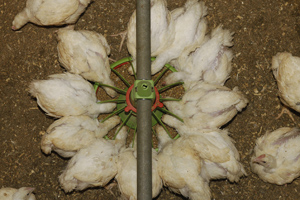Limiting DDGS inclusion in broiler diets

Research was conducted at the NC State University in Raleigh, NC USA, to evaluate the effect of inclusion level and estimated metabolisable energy (ME) values of DDGS on pellet quality, nutrient digestibility, incidence of footpad lesions, and broiler live performance.
It showed that up to 30% of DDGS can be used when broiler diets are formulated on a digestible AA basis. However, it is still unclear what the maximum dietary inclusion level of DDGS should be, when the diets are formulated on a CP basis. The ME value of DDGS is generally calculated based on crude fat (CF), protein, and fibre content.
Crude fat can be determined by ether extract or by including a more complicated acid hydrolysis pre-treatment, which yields about 2% higher crude fat value in DDGS and thus about 2.2% higher estimated ME value.
A total of 1,260 male broiler chicks were randomly distributed among 5 treatments with 6 replicate pens per treatment and 35 chicks per pen. The treatments consisted of a control diet without DDGS and a factorial arrangement of two analytical methods for CF analysis (AOAC 920.39 and 954.02) and 2 dietary DDGS inclusion levels (15 and 30%). The DDGS ME values used for feed formulation were 2,631 and 2,689 kcal/kg. A common starter diet containing 6% DDGS was fed in crumbled form, while the experimental grower and finisher diets were fed in a pelleted form.
Feed consumption and body weight were determined at 14, 35, and 49 days of age, and feed conversion ratio (FCR) calculated by using the bodyweight of all dead birds. At 35 and 49 days ileal samples were obtained for nutrient digestibility analyses. At 50 days of age footpad lesions were evaluated. The analytical method 954.02 resulted in lower mixer fat addition and improved pellet quality. In contrast, increasing DDGS inclusion level to 30%, reduced pellet quality, as well as reduced bodyweight, feed efficiency, protein digestibility, and increased the incidence of footpad lesions. Broilers can be fed up to 15% DDGS when diets are formulated on a CP basis, and the method of estimating CF and ME has marginal effect on live performance.
Source: Wilmer Pacheco, Adam Fahrenholz, Charles Stark, Peter Ferket, John T. Brake, North Carolina State University, Raleigh, NC USA
Proceedings International Poultry Scientific Forum (2014), Atlanta, GA, USA
Join 26,000+ subscribers
Subscribe to our newsletter to stay updated about all the need-to-know content in the feed sector, three times a week. Beheer
Beheer









 WP Admin
WP Admin  Bewerk bericht
Bewerk bericht